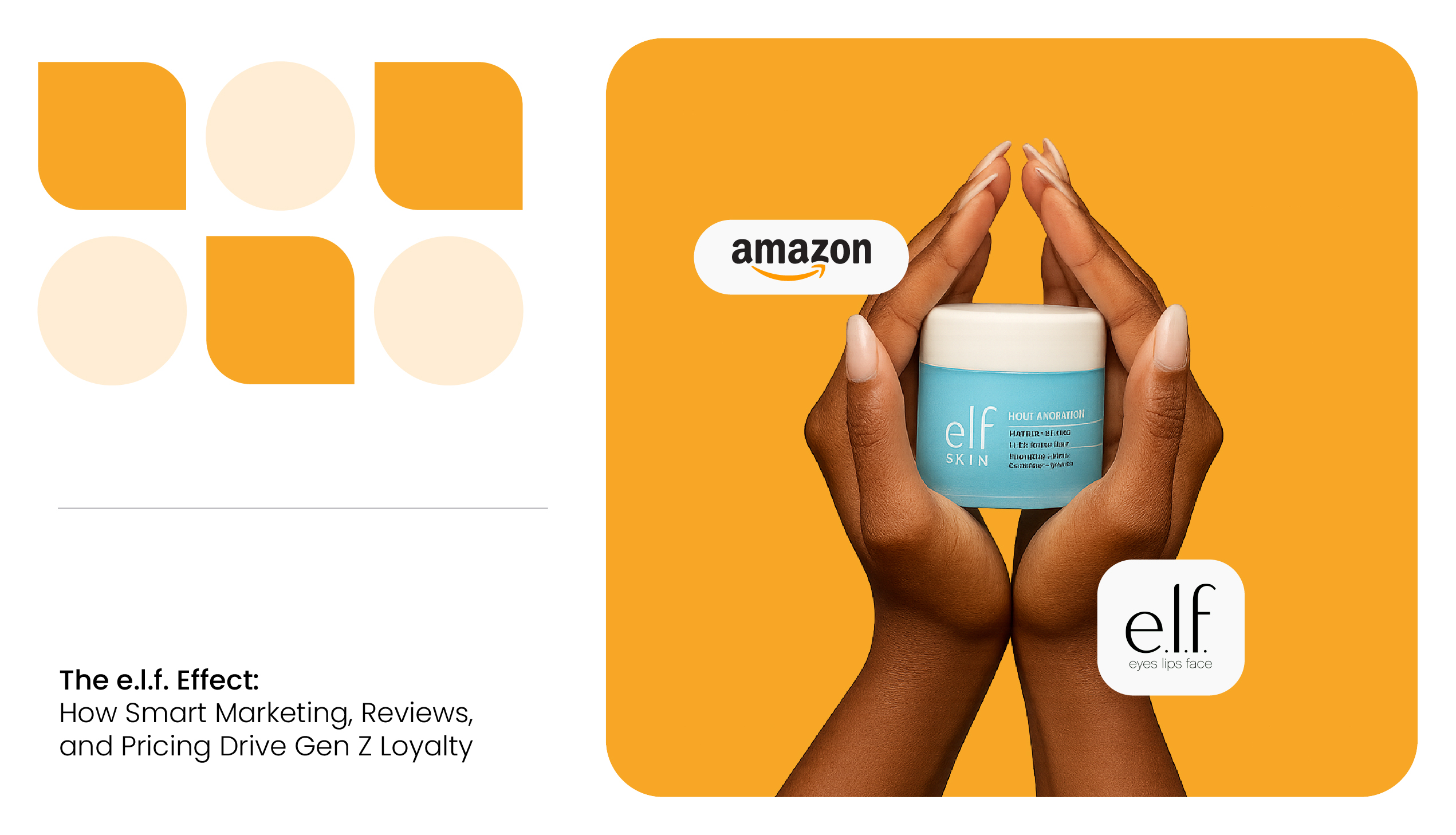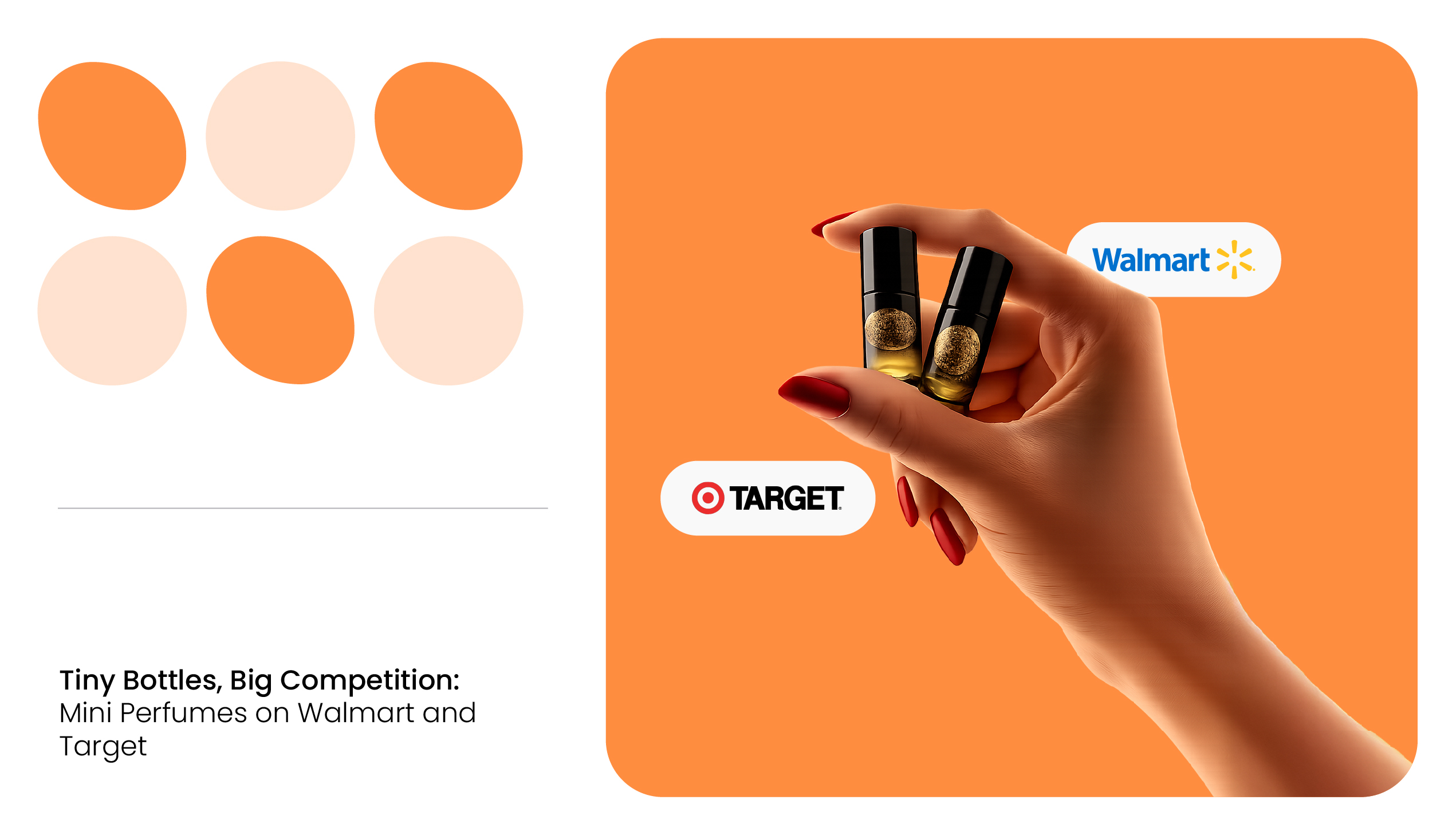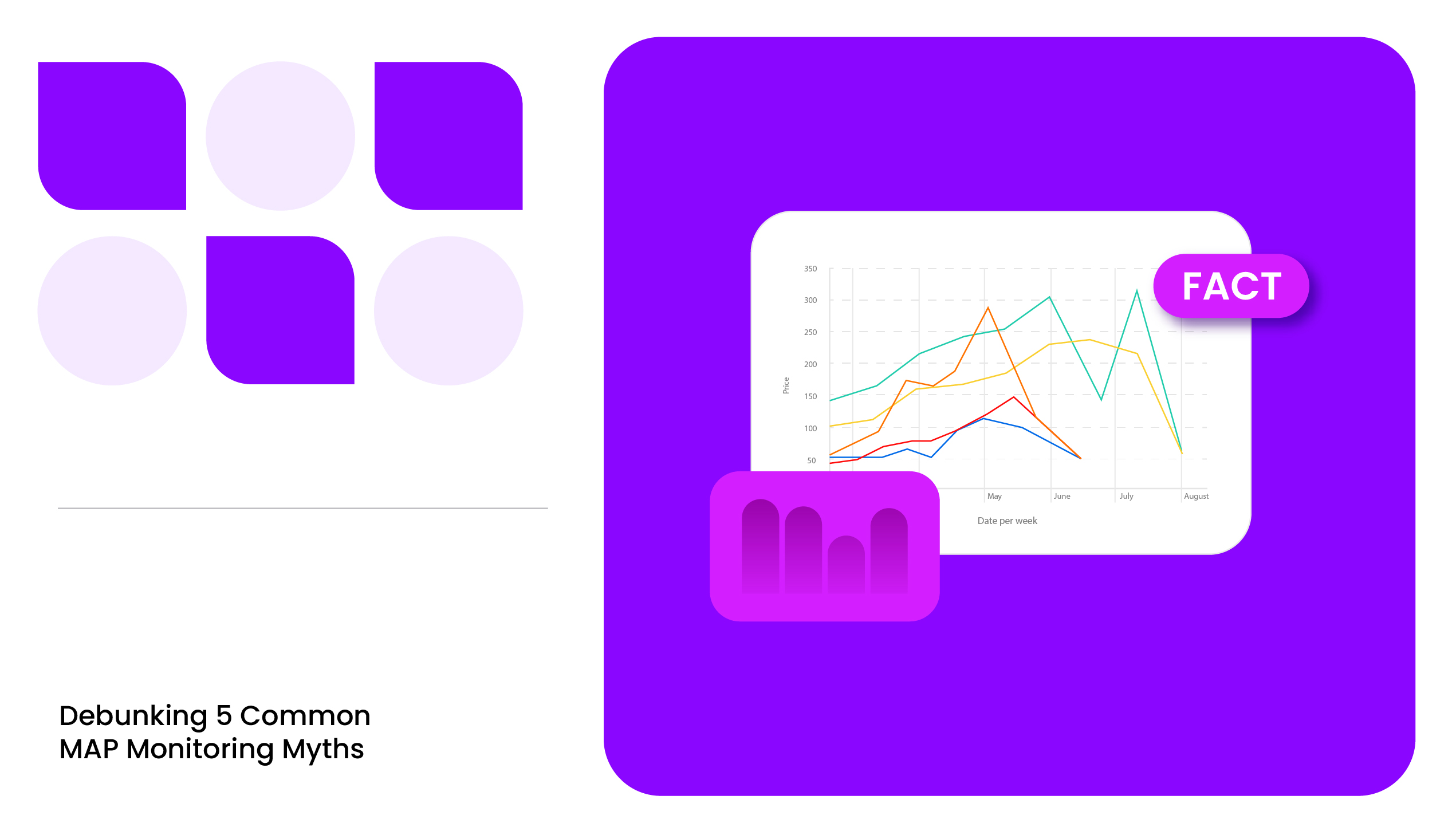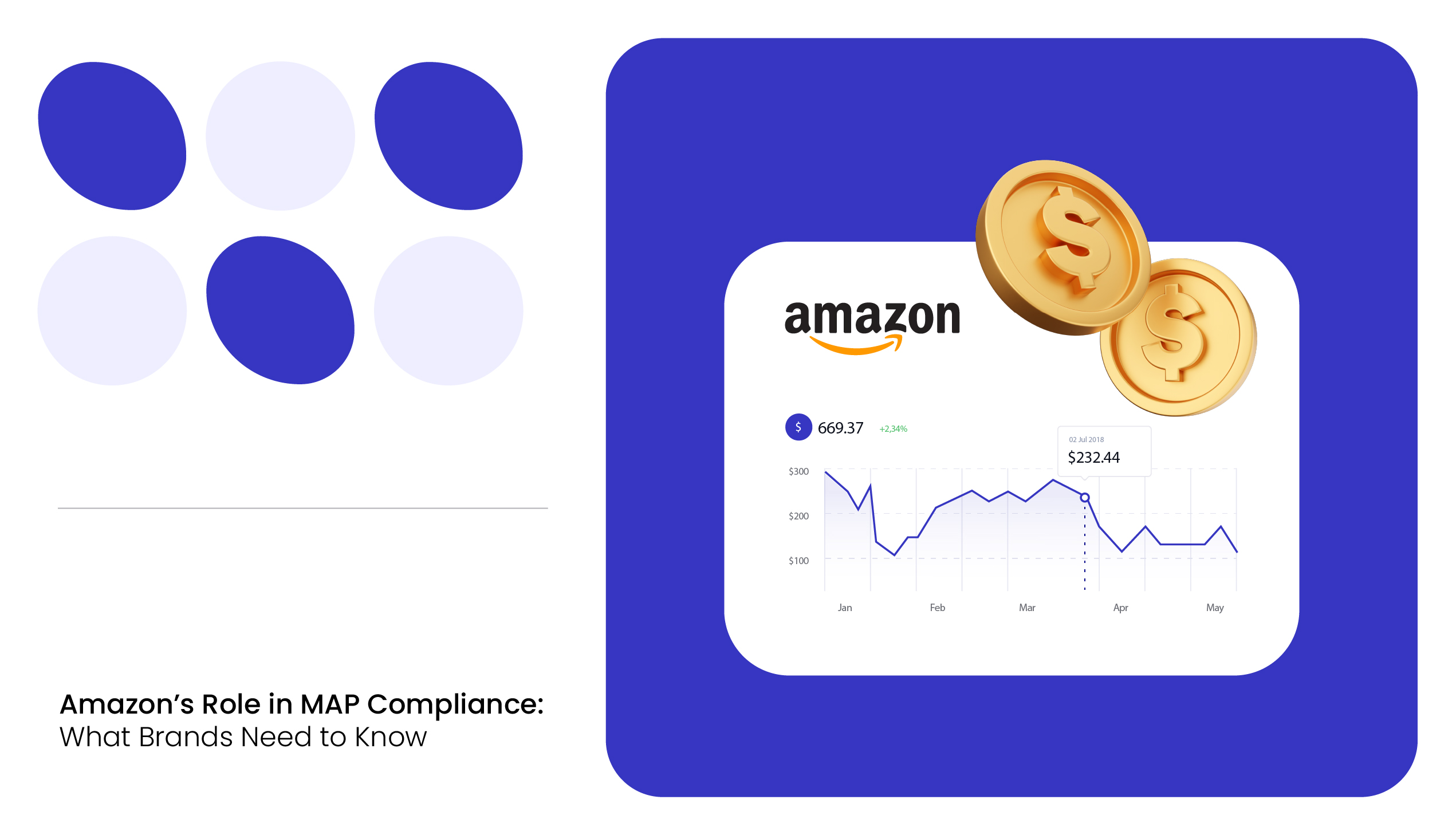About the Report: This Digital Shelf Insights (DSI) report covers e.l.f. Cosmetics on Amazon between July 14 and 27, 2025. Using MetricsCart’s digital shelf intelligence platform, we analyzed 658 e.l.f products across 72 categories. The report also looks at e.l.f.’s 110 sponsored products to understand its paid visibility strategy.
Introduction
On Amazon, e.l.f. Cosmetics’ 658 products average a price of just $9.91, backed by 86 million reviews with a 4.37 rating, making it a rare combination of affordability, consumer trust, and digital shelf dominance.
In a category where prestige brands often rely on higher pricing and heavy celebrity influence, e.l.f. has built its playbook around dupe culture, viral marketing, and review-driven credibility.
At the same time, with the Rhode acquisition, the company is expanding its reach into the premium skincare space, striking a balance between mass affordability and prestige aspiration.
e.l.f. Cosmetics marketing strategy has become a case study in how affordability and community-driven marketing can outpace legacy beauty giants. According to MetricsCart data from Amazon, their pricing strategy and customer review trends reveal how challenger brands are rewriting the playbook.
This report sheds light on how e.l.f. leverages agile marketing, competitive pricing, and customer reviews to win in the mass beauty space, the impact of their Rhode acquisition, and what it means for other beauty players.
Highlights
- e.l.f. Cosmetic products have over 86 million reviews, with an average rating of 4.37.
- The Monochromatic Multi Stick is the most reviewed e.l.f. product on Amazon, with 82K reviews across multiple variations.
- The Dual Pencil Sharpener is the most affordable e.l.f. product on Amazon, at $2.00.
- The Intense Ink Eyeliner is the most expensive e.l.f. product on Amazon, priced at $67.
- Sponsored products are most concentrated in Foundations (17 SKUs), averaging $7.9.
e.l.f. Cosmetics Marketing Strategy: From TikTok Virality to Rhode Acquisition
e.l.f. Cosmetics has built a marketing engine that fuses viral, social-first momentum with bold brand positioning to expand its market reach. e.l.f. Cosmetics business model demonstrates how digital-native marketing, cultural relevance, and portfolio diversification can fuel growth in the beauty and personal care industry.
Viral-First, Culture-Driven Marketing
At the core, e.l.f. Cosmetics’ growth strategy is focused on viral, trend-driven content. The brand’s #eyeslipsface campaign is widely recognized as a breakthrough in integrating user-generated content, music, and meme culture to generate massive engagement.
Rather than relying solely on traditional media, e.l.f. prioritizes cultural relevance by transforming jokes, memes, and online moments into product-centric storytelling. This provides a speed advantage over legacy beauty brands, allowing e.l.f. to respond quickly to shifting trends.
The brand’s strategic investments in sports partnerships, ranging from women’s football and hockey to racing, reflect a deliberate move to embed beauty into unexpected cultural contexts. These collaborations are more than sponsorships; they signal an effort to reach underserved “beauty deserts” and diversify the brand’s audience.
Escalating Marketing Investment & Disruption
e.l.f. has significantly increased its marketing spend, reaching 25% of net sales in 2024 and peaking at ~34% in certain quarters—a notable rise from 7% five years earlier.
In May 2025, e.l.f. reported that net sales increased 28% to $1,313.5 million, primarily driven by retailer and e-commerce channels, as well as geographically across the US and international markets.
This aggressive investment underpins e.l.f. Cosmetic marketing engine, a growth pillar alongside product value and innovation. The brand frequently leverages shock-value campaigns to spark conversation, such as the “So Many ‘Dicks’” initiative advocating for boardroom diversity, which drove media attention and consumer discourse.
Innovation in Partnerships & Brand Extensions
Beyond beauty products, e.l.f. extends into adjacent cultural territories. By fusing beauty with sports and other lifestyle domains, the brand connects with nontraditional audiences and reinforces a culturally intersectional identity.
Additionally, cause-driven campaigns—focusing on gender equality and leadership diversity—serve as brand statements that reinforce e.l.f.’s values-led positioning.
Rhode Acquisition: Turning Viral into Prestige
The acquisition of Rhode, the Hailey Bieber–launched lifestyle beauty brand, represents a strategic leap for e.l.f., signaling a shift from mass disruption toward a hybrid mass + prestige model.
In May 2025, e.l.f. signed a definitive agreement to acquire Rhode in a deal valued at up to $1 billion (cash, stock, and potential earnouts). Rhode adds a prestige-tier brand with high cultural cachet and digital-native marketing capabilities, complementing e.l.f.’s disruptive DNA.
In Q1 post-acquisition, e.l.f. reported 9% YoY net sales growth to $353.7 million, attributing part of the increase to Rhode’s integration.
Rhode’s DTC and social-first origin enhances e.l.f.’s digital footprint. Its expansion into Sephora stores in the US, Canada, and the UK will test the ability to convert virality into sustained retail presence.
While e.l.f.’s marketing engine thrives on cultural relevance and viral campaigns, its impact is only sustainable because the brand anchors everything in pricing discipline. Let’s look into the MetricsCart data, which reveals e.l.f.’s pricing strategy and its impact on customer reviews.
Average Price vs. Ratings of Top e.l.f. Cosmetics Categories on Amazon
Unlike legacy brands that depend on prestige pricing to signal exclusivity, e.l.f. structures its portfolio to keep most products under $15, striking a balance between affordability and quality perception.
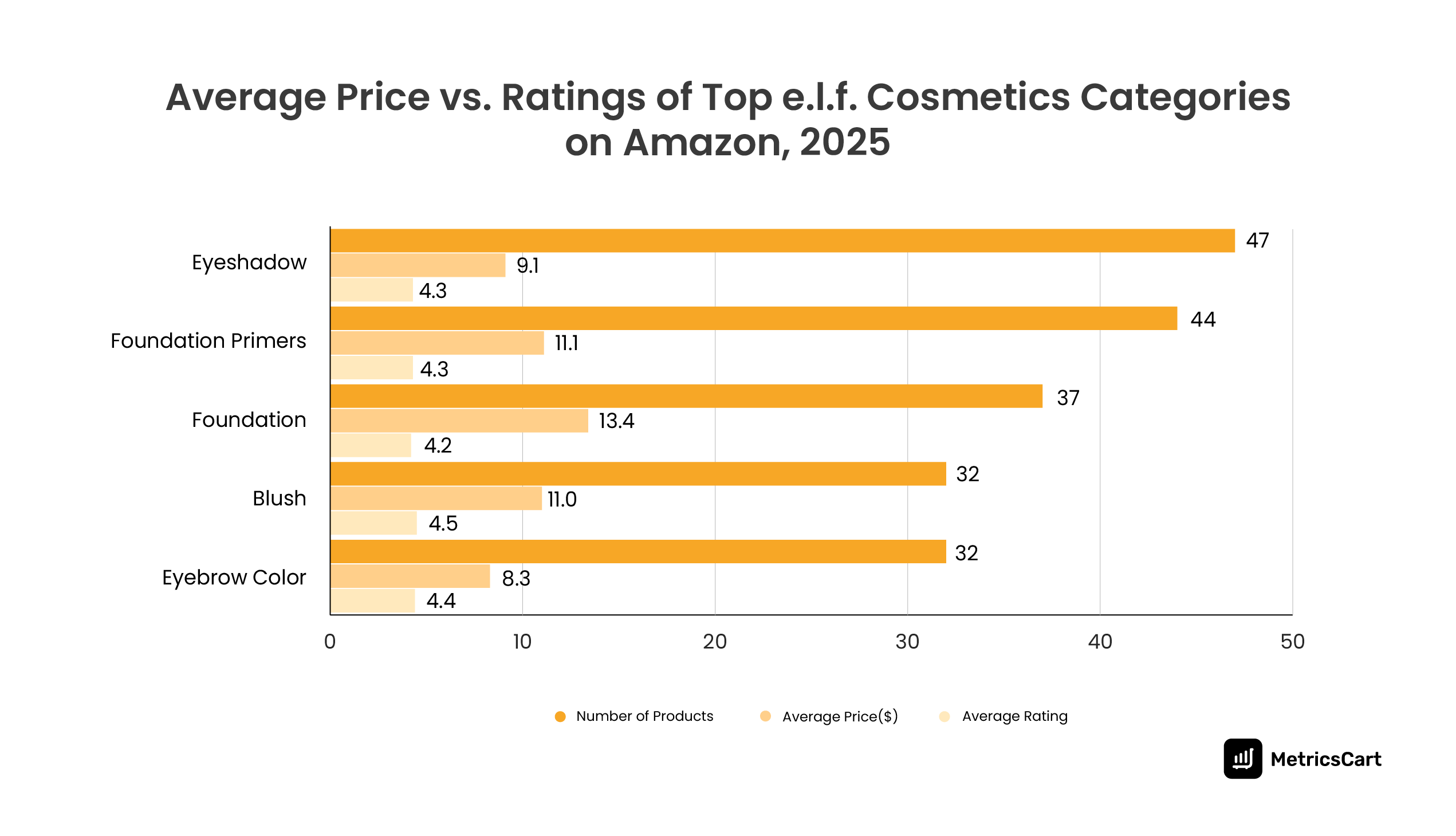
e.l.f. dominates across categories, from eyeshadow (47 SKUs) to foundations (37) and lip glosses (27). This breadth helps them meet Gen Z’s experimentation mindset without forcing high spend.
Most categories have an average price range between $9 and $13, with eyeshadow at the lowest, at $9.10, and foundation at the highest average, at $13.40. This range positions e.l.f. as “premium enough” for quality, but still more affordable than legacy competitors like MAC or Fenty.
Categories tied to daily use or complexion, such as foundation, moisturizers, and concealers, are priced slightly higher ($11–$13). This signals a deliberate strategy: charge a small premium where performance and trust are most critical, while keeping impulse categories (eyeshadow, lip gloss) under $10 to drive trial and volume.
Despite the low pricing, ratings rarely dip below 4.1, with blush (4.5) and eyebrow color (4.4) topping satisfaction. High review scores show that affordability hasn’t come at the cost of perceived quality.
Average Price Trends of e.l.f. Cosmetics Products on Amazon
While e.l.f. plays across multiple categories at different price points, the brand keeps its overall portfolio pricing tightly anchored around the $10 mark.
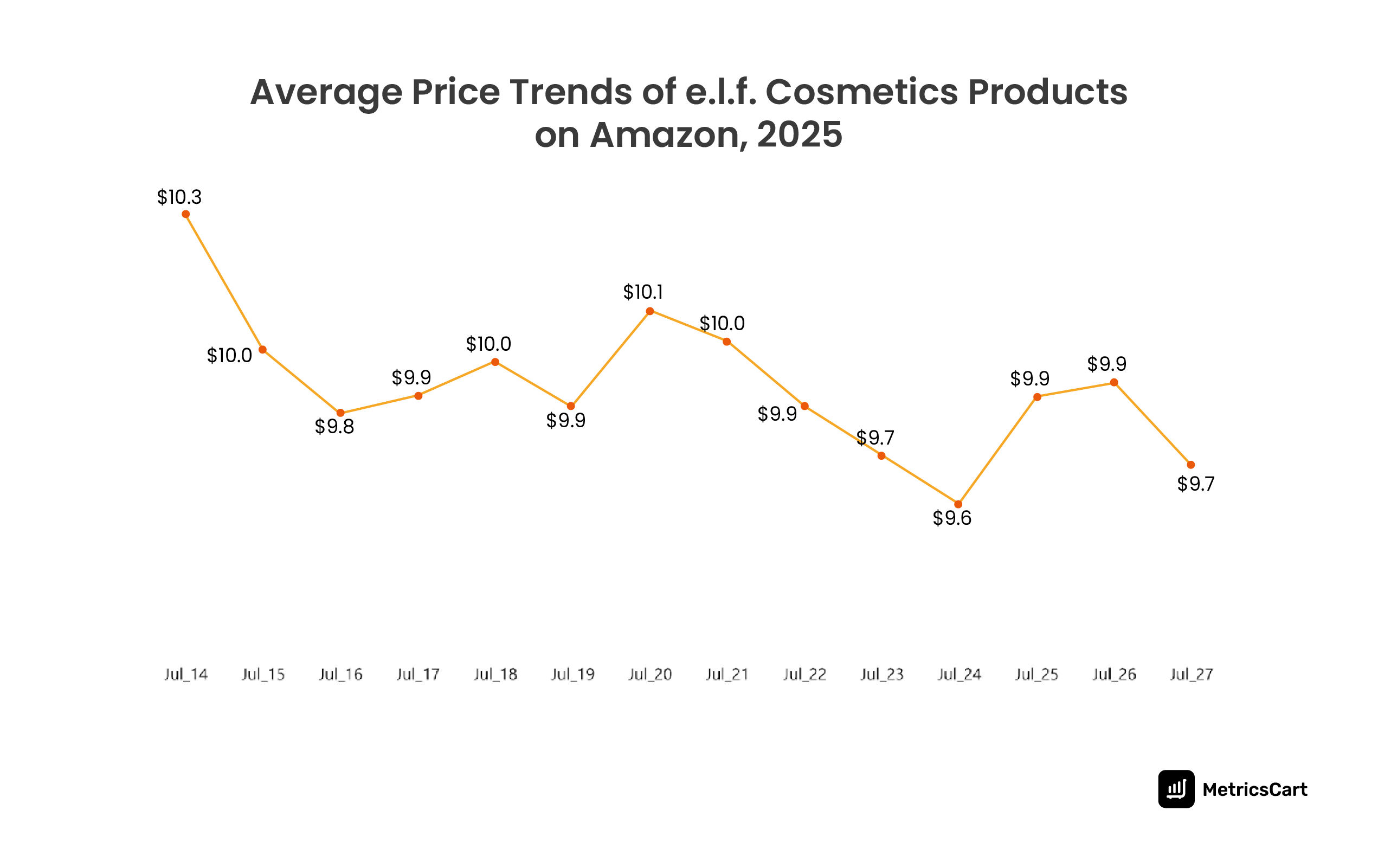
Between July 14 and July 27, 2025, the average price fluctuated only within a narrow band of $9.6 to $10.3. This consistency signals a deliberate pricing model, ensuring that affordability remains central to e.l.f.’s identity, even as campaigns and product pushes create short-term variations.
The trend also reflects a balancing act between promotional tactics and portfolio stability. Spikes on July 20 ($10.1) and dips around July 24–25 ($9.6) suggest tactical price adjustments, likely linked to sponsored visibility or demand surges for specific categories.
However, the reversion back toward ~$9.9 highlights e.l.f.’s commitment to not letting temporary campaigns disrupt its “affordable premium” perception.
Most Expensive e.l.f. Cosmetics Products on Amazon: Intense Ink Eyeliner and Ultimate Makeup Brush Set
While e.l.f. is known for its average pricing of around $10, a closer look at its top-tier products reveals how the brand strategically pushes into higher price points without abandoning its core identity of affordability.
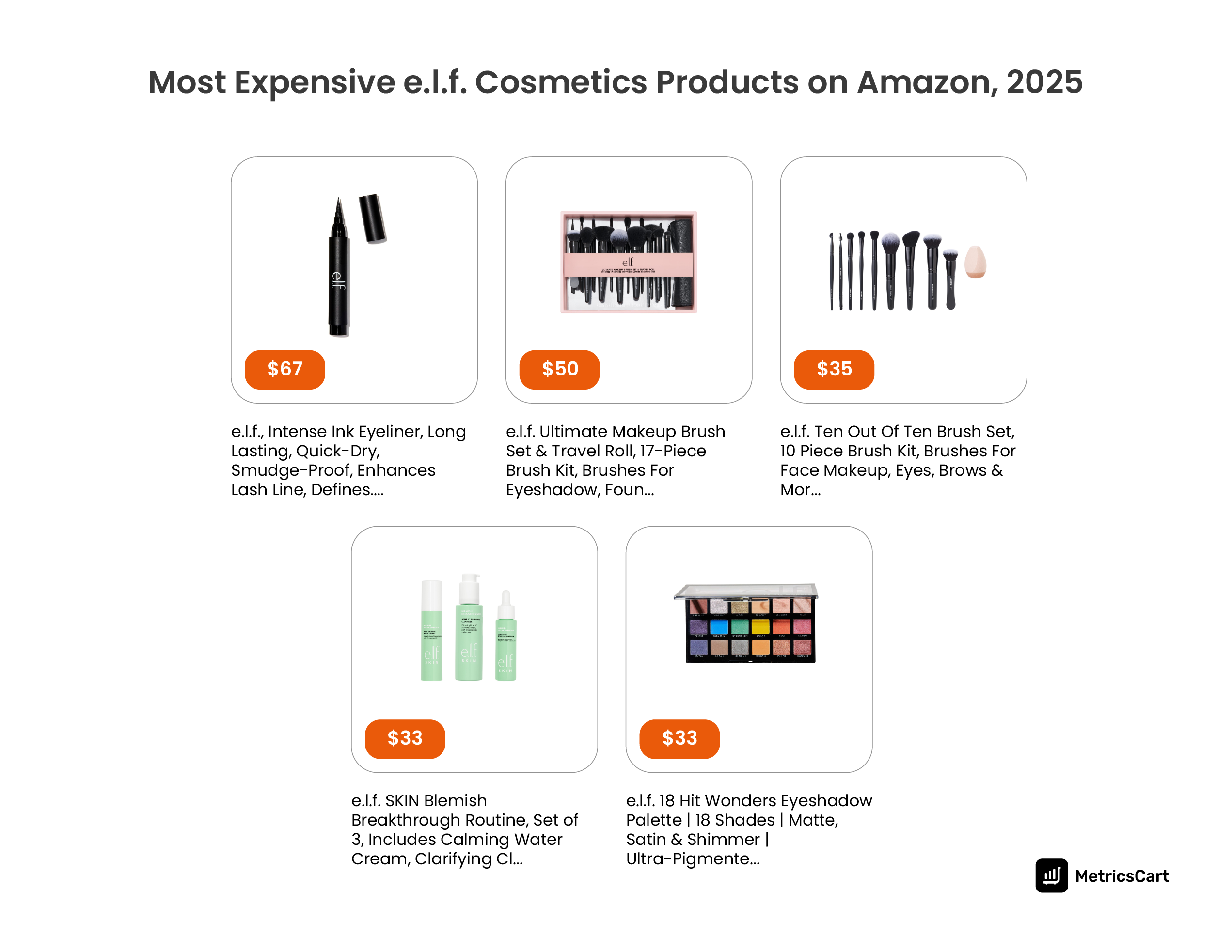
Intense Ink Eyeliner, priced at $67, is the highest-priced SKU, reflecting demand for high-performance, long-lasting products.
In addition, makeup brush sets dominate the premium tier with the Ultimate 17-piece kit ($50) and Ten Out of Ten brush kit ($35). These items highlight e.l.f.’s ability to scale utility-based value at higher price points.
In addition, SKIN Blemish Breakthrough Routine ($33) and Nourishing Facial Oil ($33) show how skincare allows the brand to stretch its price ceiling. These align with e.l.f.’s Cosmetics business strategy in the Rhode acquisition; bridging mass affordability with prestige aspirations.
The most expensive listings include multi-piece brush sets, skincare kits, and high-value bundles. These products serve dual purposes: they elevate the brand into more “prestige-like” pricing tiers while also anchoring e.l.f.’s reputation for value by delivering quantity and perceived utility at a fraction of traditional luxury prices.
Premium bundles and skincare routines complement viral entry-level products, creating a laddered portfolio where consumers can “trade up” without leaving the brand ecosystem. By embedding higher-priced offerings into its Amazon mix, e.l.f. also signals to the market that its value proposition extends beyond budget makeup into premium skincare and multi-use tools.
Most Affordable e.l.f. Cosmetics Products on Amazon: Dual Pencil Sharpener and Blending Eye Brush
At the other end of the spectrum, e.l.f. Cosmetics on Amazon anchors its accessibility strategy with ultra-low-priced products, many of which are priced at just $2.00–$2.80. These entry-level SKUs include sharpeners, concealer brushes, lip liners, and brow tools —items that serve as both functional necessities and easy add-ons to the cart.
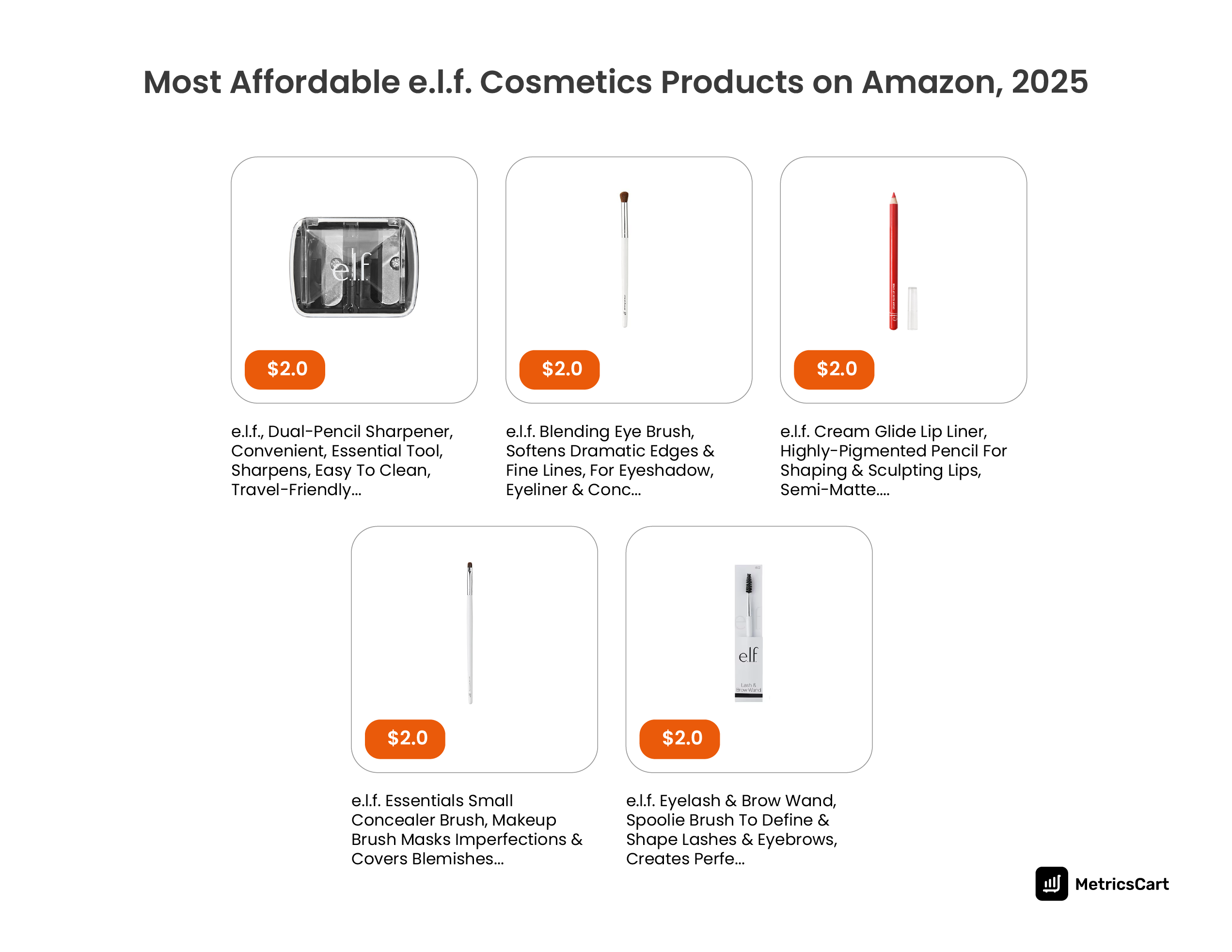
MetricsCart data shows that the lowest-priced e.l.f. Cosmetics on Amazon are tools and accessories such as pencil sharpeners, brushes, spoolies, and applicators.
These products are priced at $2. A few core cosmetics, such as lip liners and concealer sticks, are also priced at entry level.
Additionally, these low-cost products drive impulse buying and serve as “basket builders,” increasing cart value with minimal resistance. Moreover, they drive virality as $2–$3 SKUs are easy for influencers to showcase as “must-have cheap hacks,” spreading organically on TikTok and Instagram.
Average Price vs. Product Count of Sponsored e.l.f. Cosmetics Categories on Amazon
E.l.f. cosmetics marketing strategy prioritizes complexion categories like foundation, blush, and highlighters in its sponsorship strategy.
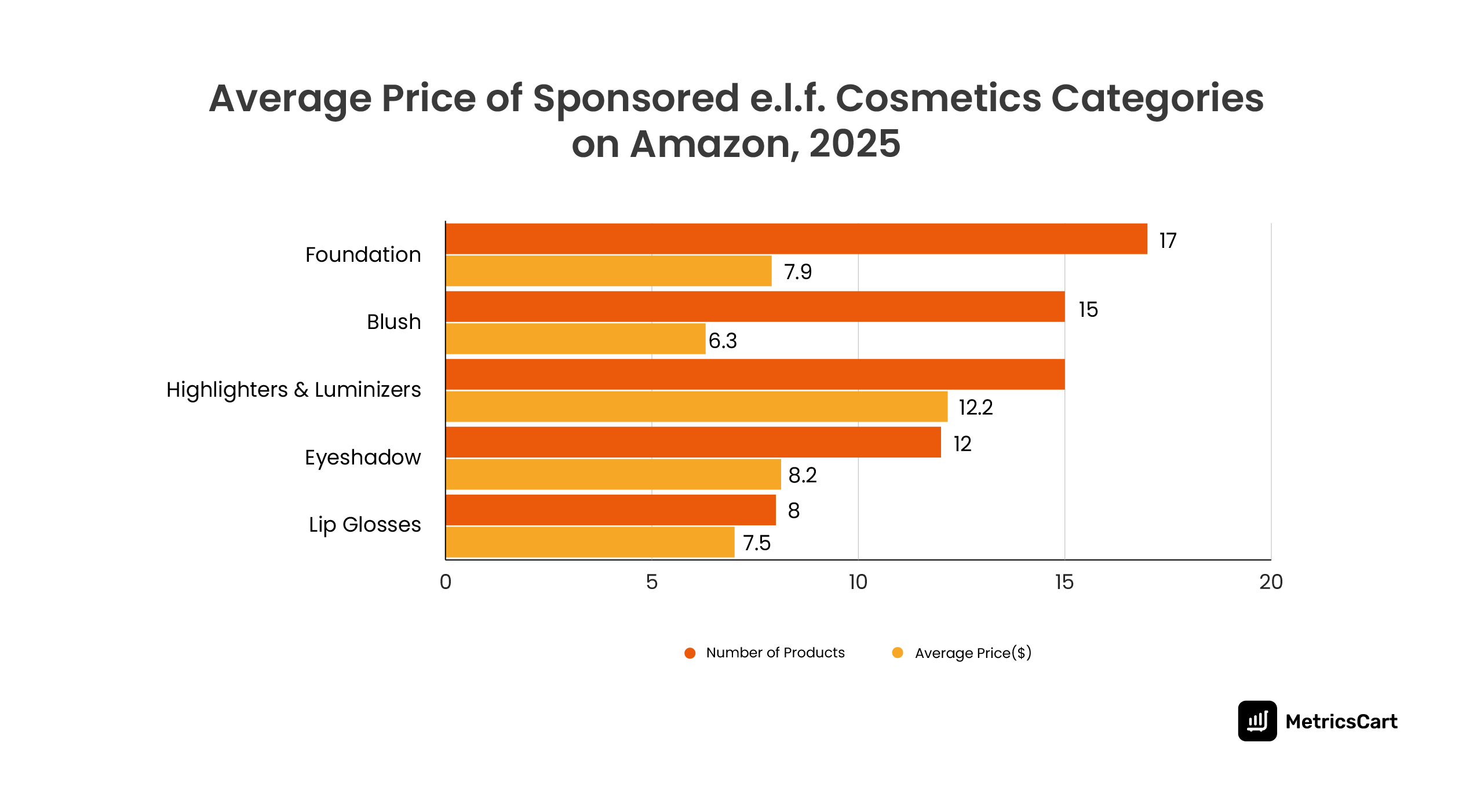
With 17 sponsored SKUs in foundation ($7.9) and 15 each in blush ($6.3) and highlighters & luminizers ($12), e.l.f. ensures that its most credibility-dependent products stay visible. These categories act as trust anchors for consumers, reinforcing the brand’s reliability in performance-driven segments.
Additionally, affordable, high-volume categories such as eyeshadow and lip glosses continue to be central to sponsored visibility. With 12 sponsored eyeshadows and eight lip glosses priced around $8, these products drive trial and engagement, fueling virality and repeat purchases. Sponsorship ensures e.l.f. sustains dominance in impulse-friendly, trend-driven categories.
Review Trends of e.l.f. Cosmetics Products on Amazon
e.l.f.’s review trends on Amazon highlight how its disciplined pricing and viral-first marketing translate into consumer engagement and validation.
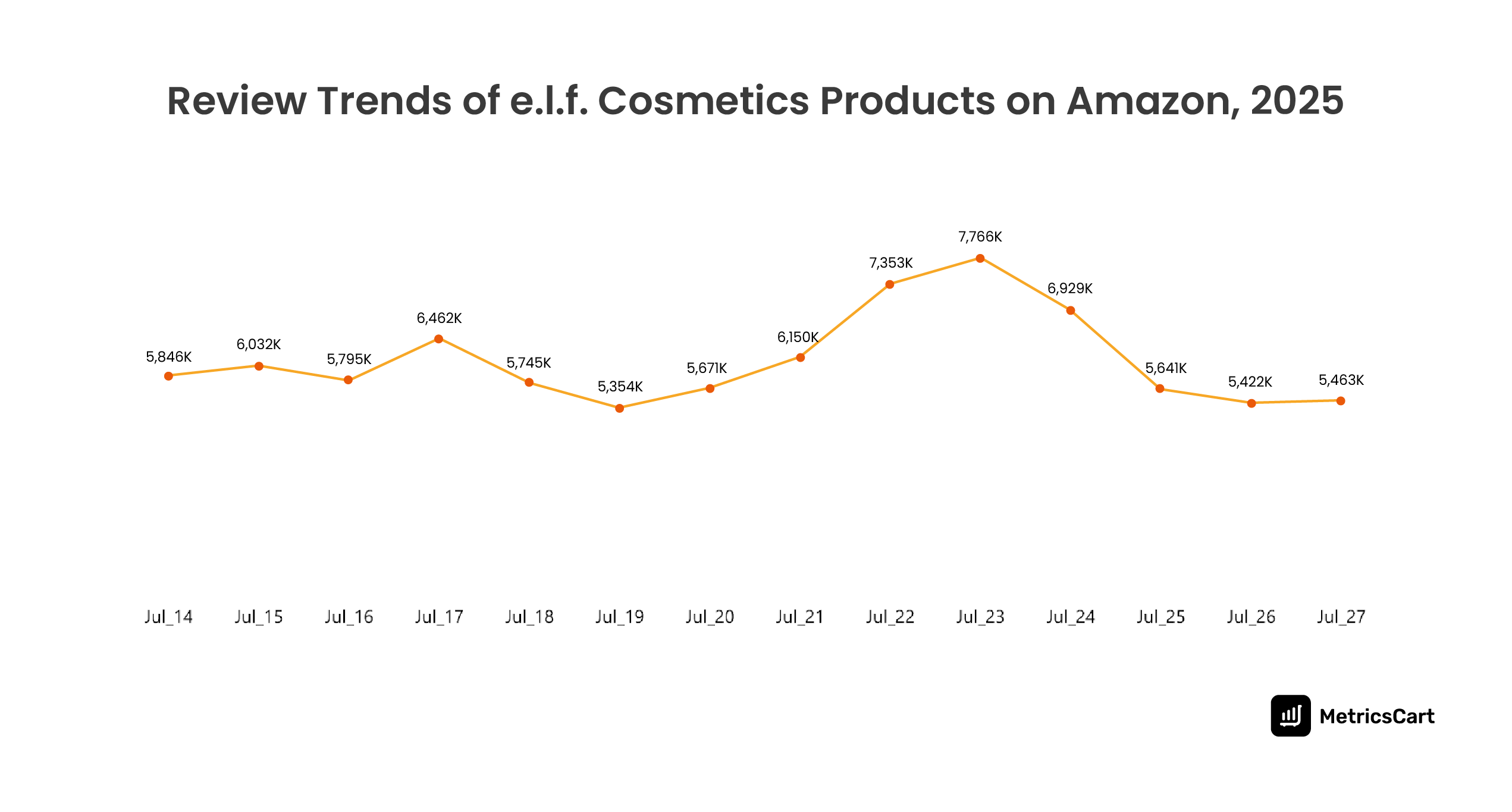
Between July 14 and July 27, 2025, daily review volumes ranged from ~5,300 to 7,700 reviews, with noticeable spikes coinciding with tactical pricing and marketing efforts.
Based on the MetricsCart data analysis, the peak of 7,766 reviews on July 23 corresponds to a period when average prices dipped below $10, reinforcing how trial-friendly pricing accelerates consumer feedback. This shows how affordability lowers the barrier to trial, while aggressive marketing ensures those trials convert into feedback loops of reviews and ratings.
With a floor of ~5,300 reviews per day, e.l.f. demonstrates a durable consumer base that maintains steady engagement beyond campaign-driven peaks. High volumes combined with strong ratings (~4.3–4.5 across categories) show that affordability does not compromise trust—turning reviews into proof points that strengthen e.l.f.’s marketing claims.
READ MORE | Confused about How to Use Reviews for Marketing Initiatives? Dive into Boosting Marketing Strategy with Reviews: 8 Effective Methods for Brands
Most Reviewed e.l.f. Cosmetics Product on Amazon: Monochromatic Multi Stick
The most reviewed e.l.f. Cosmetics on Amazon underline how pricing and marketing intersect to create hero SKUs that anchor the brand’s credibility.
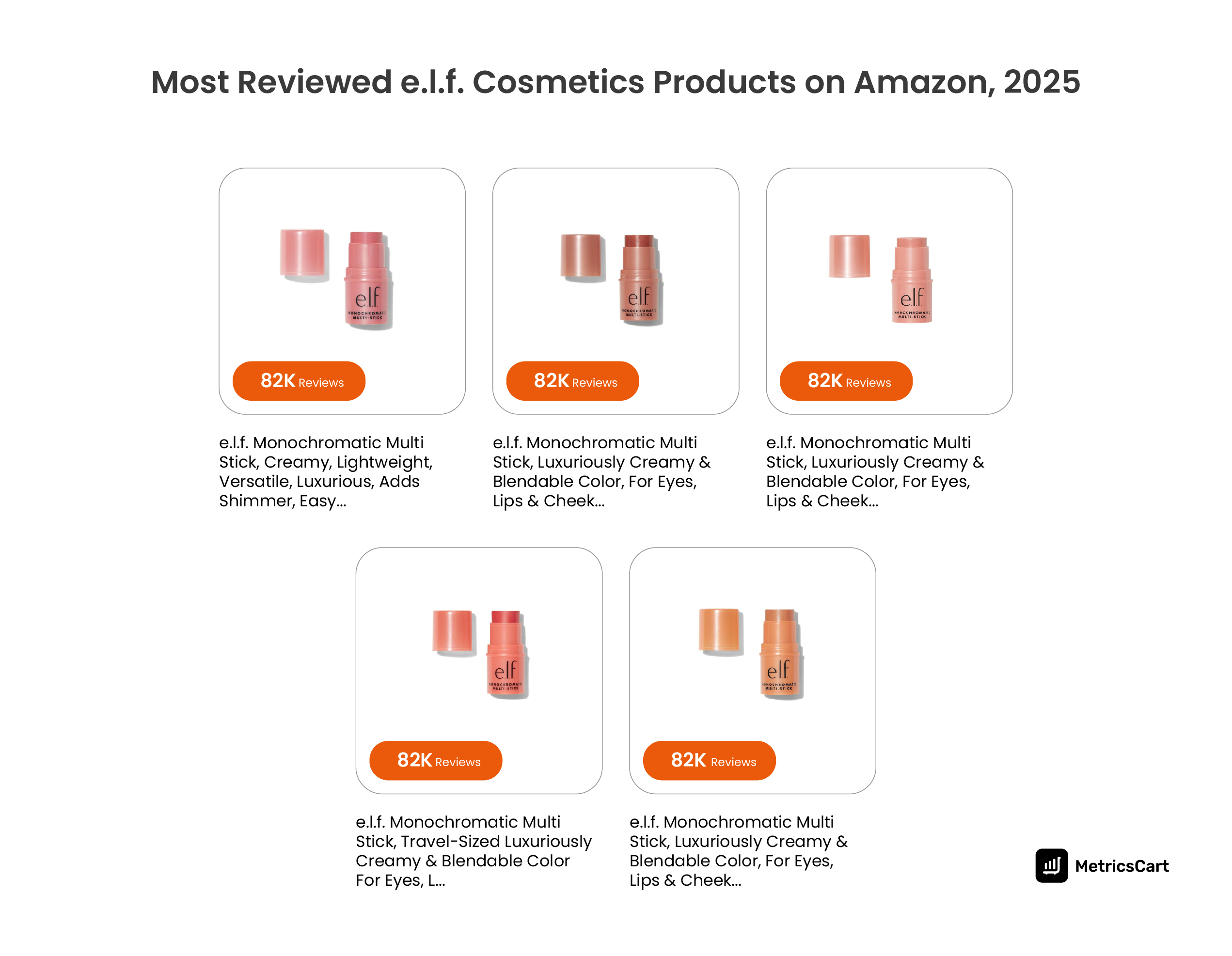
At the top, the Monochromatic Multi Stick dominates with 82K reviews across multiple variations, making it one of e.l.f.’s most culturally visible products.
The Multi Stick’s cross-functionality (eyes, lips, cheeks) aligns with Gen Z’s preference for simple, trend-driven products, making it highly shareable and review-worthy. Its affordability, versatility, and viral presence on TikTok have transformed it into a flagship item that embodies e.l.f.’s accessible yet trendy appeal.
In the complexion products category, the Camo Concealer line also stands out, with the 16HR Matte and Hydrating variants each garnering between 51,000 and 63,000 reviews. These products reinforce consumer trust in performance-driven categories—areas where quality perception is non-negotiable.
Together, the Multi Stick and Camo Concealer families demonstrate how e.l.f.’s Cosmetics marketing strategy directly translates into increased review volume, reinforcing a cycle of credibility and purchase momentum.
What Brands Can Learn from e.l.f. Cosmetics’ Marketing Strategy
E.l.f. Cosmetics marketing strategy signals several important insights for brands navigating the digital shelf:
- Affordability Can Be a Growth Engine, Not a Limitation: e.l.f. Cosmetics on Amazon prove that keeping products under $15 does not dilute brand equity. Instead, it expands trial, accelerates review generation, and drives repeat purchases.
- Virality Works Best When It’s Culturally Tuned: From the #eyeslipsface campaign to sports sponsorships, e.l.f. shows how brands can translate cultural moments into authentic storytelling.
- Reviews Are the New Currency of Trust: e.l.f. leverages affordability to generate millions of reviews that validate quality and feed Amazon’s algorithms. Other brands should design pricing and sampling strategies to maximize review velocity—turning feedback into a scalable credibility engine.
- e-Mass Integration: The Rhode acquisition demonstrates e.l.f.’s ability to balance mass accessibility with premium relevance.
By blending affordability, cultural relevance, viral marketing, and community engagement—measured and analyzed through platforms like MetricsCart—e.l.f. Cosmetics sets a clear blueprint for beauty and CPG brands competing in digital-first retail.
Disclaimer: MetricsCart is the exclusive owner of the data used in the Digital Shelf Insights reports. Any kind of third-party usage entails due credit to the source material.
Want to Elevate your Marketing Strategy like e.l.f. Cosmetics?

